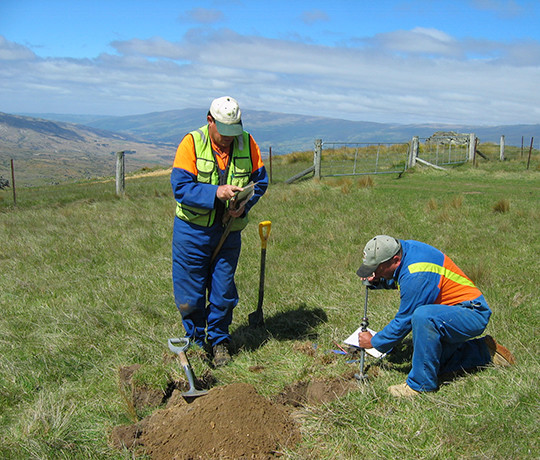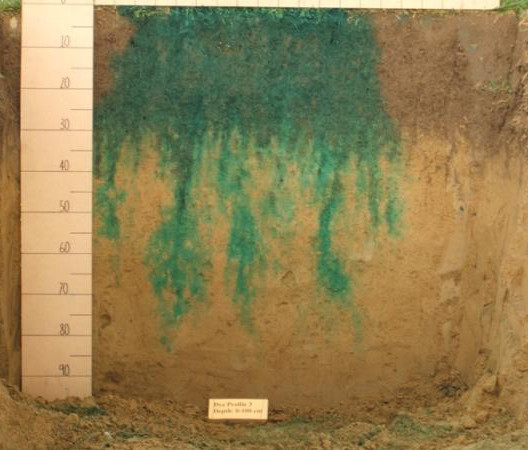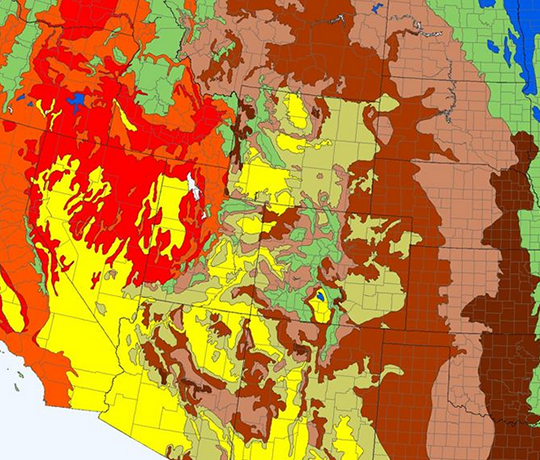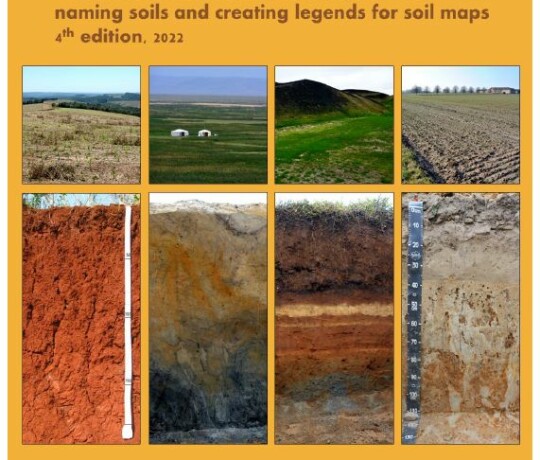New Zealand Soil Classification (NZSC)
The NZSC was developed in the 1980s
The NZSC classification grew out of the New Zealand Genetic Soil Classification and, where possible, preserved its useful features. The system was also influenced by local experience in testing the United States soil classification system.
Current System
The top three levels of the NZSC classification - order, group, and subgroup - are defined by Hewitt (2010), the fourth and fifth levels (family and sibling) by Webb and Lilburne (2011). The fourth level (soilforms) by Clayden and Webb (1994) were replaced by the family and sibling.
The current approach to drainage classes is highlighted here.
The resulting classification represents the best attempt to classify New Zealand soils, at our current state of knowledge. As knowledge and understanding of soils grows, further revisions will be necessary.
The NZSC has a hierarchical structure with five levels:
- Order: The 15 soil orders are the highest, most generalised level of the classification and provide the national overview of New Zealand soils.
- Group: The orders are divided into 74 soil groups based on variation in factors such as drainage status, parent material, chemical and physical properties.
- Subgroup: The soil groups are divided into 299 subgroups that provide more detail about the range of soils included in each soil group.
- Family: The soil subgroups are subdivided into family criteria that provide more detail about the soil parent materials, rock class, texture, and permeability.
- Sibling: The soil family are subdivided into sibling criteria that provide more detail about soil depth, stone content, upper and lower textures, and drainage. The family also contains functional horizon attributes detailing horizon stone content, texture, structure size, and consistence.
Soil siblings are described by a sequence of up to six functional horizons. Functional horizons are soil 'horizons' (layers of soil material), occurring in soil profiles, characterised by clearly defined soil morphological parameters. They are 'functional' horizons because they are used to predict soil characteristics such as profile available water and hydraulic conductivity.
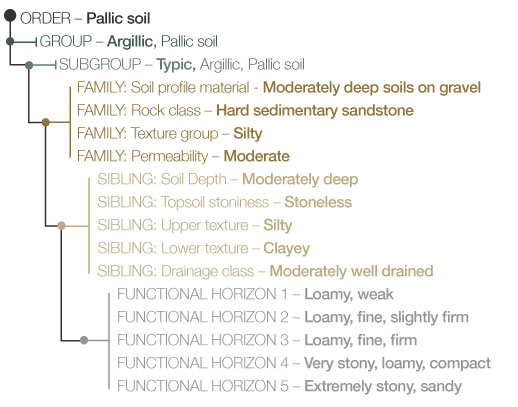
Example of a NZSC Hierarchical Structure
To find the correct soil class for a soil we examine the soil horizons (or layers) exposed in the side of a freshly dug soil pit, usually to the depth of about 1 m (unless rock is found at a shallower depth). We then assign the soil to the correct soil class, by using the keys to orders, groups, and subgroups in Hewitt (2010) and family and sibling criteria in Webb and Lilburne (2011). The simplified key below provides a guide to the correct soil order. The keys for assigning a soil to the correct soil class use diagnostic horizons and other defined soil features.
| Soils dominated by organic material | Organic Soils | |
| Grey colours due to reduction of iron caused by waterlogging beneath a high water table | Gley Soils | |
| Soils disturbed by people (made by stripping or mixing the original soil material to depth or by addition of fill) | Anthropic Soils | |
Minimal soil development |
||
| Soils on young land surfaces where rock material or sediments in which the soil is formed are fresh and little altered | ||
| No topsoil or minimal topsoil | Raw Soils | |
| With a distinct topsoil | Recent Soils | |
Intermediate soil development |
||
| Soils where the rock material or sediments in which they are formed are altered but still recognisable, with a large proportion of unaltered minerals. The soils have well-developed subsoil horizons if not on shallow rock | ||
| Dominated by allophane (from volcanic parent materials, weathered sandstone or derivatives) | Allophanic Soils | |
| Dominated by pumice or sandy glassy tephra | Pumice Soils | |
| Dominated by high calcium or magnesium from lime-rich rocks or dark basic igneous rocks | Melanic Soils | |
| Light coloured rocks or sediments | - Semi-arid climate, rainfall less than about 500 mm/year | Semiarid Soils |
| - Subhumid climate with seasonal drought | Pallic Soils | |
| - Humid climate, rarely dry except if sandy or stony where they may be drier | Brown Soils | |
| - Super-humid climate | Podzol Soils | |
Strong soil development |
||
| Soils on old land surfaces where the rock material or sediments in which the soil is formed are mostly transformed to clay | ||
| Mainly sedimentary rocks | Ultic Soils | |
| Mainly volcanic rocks | - Well-developed polyhedral structure | Granular Soils |
| - Dominated by iron and aluminium oxides | Oxidic Soils | |
Definitions of the diagnostic horizons or diagnostic features are more restrictive than definitions of horizon notations (for example, thickness limits are imposed on many diagnostic horizons). The relationships shown here are therefore only approximate.
Complete lists and definitions of soil horizon notations are given in Milne et al. (1995), and diagnostic horizons, soil materials and soil features are given in Hewitt (2010).
The soil classification can be used to trace the formation, or evolution, of New Zealand soils through time.
The diagram below illustrates major pathways in the evolution of New Zealand soils.
In (I) Mineral Parent Materials, (II) Raw Soils develop into (III) Recent Soils. The nature of the parent material then strongly determines the subsequent soil formation pathway (IV). Later, parent material becomes less important, and climate and vegetation become more important controls over the character of the soil that evolves (V).
Soils will only proceed the whole way down a soil formation pathway on relatively stable sites.
Erosion or additions of fresh sediment may impede, halt or even reverse soil evolution. Many (II) Raw Soils may never develop into (III) Recent Soils or other soils because they occur in environments with continual cycles of erosion or additions of fresh sediment.
The pathways shown represent only those likely to have occurred over extensive areas. Other pathways are omitted for clarity. For example, Allophanic Soils may also be formed in quartz, feldspar, and mica parent material, and Ultic Soils may also be formed in mafic or tephra parent materials.
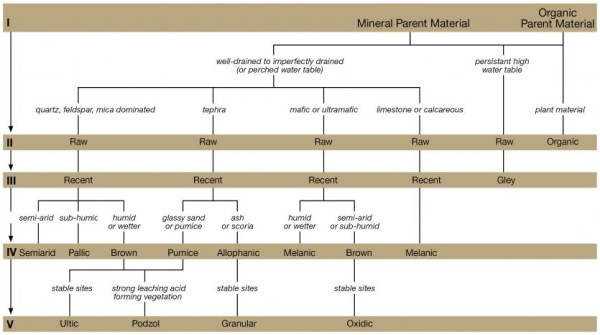
Major pathways in the evolution of New Zealand soils (click to enlarge). Source: Hewitt (1998)
